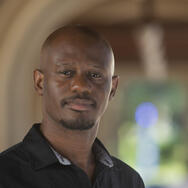Who is a Slave? Health of Children at Risk Based on Inequity, Social Acceptance of Servitude
Who is a Slave? Health of Children at Risk Based on Inequity, Social Acceptance of Servitude
A new article co-authored by Health Policy PhD candidate Vincent Jappah reveals that the modern drivers of child servitude in Liberia are largely social vulnerability and cultural acceptance of the practice, rather than traditional factors based on race and ethnicity.

Slavery victimizes tens of millions of people worldwide. In 2016, 40 million people were identified as slaves, an estimated 25% percent of them children. Given a broader definition of slavery that includes child labor and child servitude, 152 million children between the ages of 5 and 17 were child laborers as of 2016, and many millions more were involved in some form of slavery-like practice.
Stanford PhD candidate Vincent Jappah, MD, notes in his new article published in the journal Medicine, Conflict and Survival, that the gray area surrounding the acceptance of child servitude in many cultures makes formulating the correct number of victims difficult. Call it servitude or slavery, the practice diminishes the health and social well-being of children and causes harmful ripple effects in their communities as well as to the rest of the world.
Jappah notes that policies to address child servitude and other slavery-like practices are fundamental to global health policy and development. Using a health equity framework can help mitigate the negative impacts of child servitude, in that it requires addressing the diverse factors that impact a person’s ability to meet key health milestones. Irrespective of a person’s race, socio-economic status, financial and physical ability, all global citizens have the right to a healthy life.
The study, “The political economy of child service in Liberia, West Africa,” co-authored by Jappah and Danielle Taana Smith, a professor of African American Studies at Syracuse University, notes that modern slavery is often centered around alleviating one’s own personal poverty and gaining power, even if that means exploiting the children of your own community.
Both Liberian natives, the researchers note that Liberians — like those of other countries including the United States — will often target those from low socioeconomic backgrounds and indigenous peoples.
This often takes place “within groups that in many instances share similar racial identities and physical features,” Jappah said. “Today, the child next door in a neighbor’s home may be deprived of going to school and coerced into performing endless hours of chores, with poor food and living conditions, the inability to leave the house, and the constant fear of violence.”
Jappah notes child servitude can potentially have devastating health consequences, and poses a major health challenge for individuals and their communities. Many victims typically live in unsuitable and unsanitary environments often littered with mosquitos, flies, lice, and other transmitters of disease. These children may also face poor mental health outcomes such as depression, social anxiety and social dysfunction, low self-esteem and failure to meet critical developmental milestones.
Liberia is one of the poorest countries in the world, having suffered years of civil war and regional conflict. Its human development indicators rank 175 out of 189 countries on the 2019 Human Development Index. The child malnutrition rate is 15% among 5-year-olds and younger and many Liberians lack access to basic needs such as food, water, shelter, education, and health care.
In fact, the authors note, nearly 63% of the people in the West African nation established by freed American slaves live in poverty; 69% of the country’s 5 million people live on less than $3.20 a day.
“A functional economy that ensures that most citizens can earn a living wage does not exist,” the authors wrote. “Extreme poverty in some families, high levels of illiteracy and unemployment, and suboptimal economic activities contribute to child servitude and other forms of child exploitation.”
The children of Liberia are not alone. In societies with inherent instability and ongoing conflict, the practice of child servitude can become accepted as a normal way to make money and centralize power when opportunity and resources are scarce.
Jappah notes that for young children and adolescents, this is the period of forming personality, critical reasoning and developing relationships outside of the home, as well as forming opinions about the world around them. Living in such dehumanizing conditions can result in shame and trauma and often have intergenerational effects. They also have lower levels of education and higher dropout rates, contributing to an ongoing cycle of intergenerational poverty.
“These children, as all children do, internalize and, to some extent, normalize their living conditions, and society becomes more acquiescent to such practices, despite their detrimental effects,” Jappah said. “These practices are widespread in places where laws are not adequate to address them, or if there are laws, few enforcement mechanisms are in place, or they are not enforced.”
Jappah said Liberians must address their cultural history of exploitation if they want to abolish the practice of child servitude. In addition, addressing the larger issues of inequity and the exclusion of marginalized groups is necessary.
“Throughout human history, we have witnessed clashes among social classes and groups,” Jappah said. “The more inequitable a society is, the more likely it is to be rife with social tensions.”
He concluded that those tensions are evident in developing countries as well as the industrialized nations such as the United States, a Western harbor of child trafficking and slavery. According to the Global Slavery Index, on any given day in 2016 there were 403,000 people living in conditions of modern slavery in the United States — or 1.3 victims of slavery for every thousand people in this country.
“This phenomenon is universal; Liberia is not an exception,” Jappah said.

